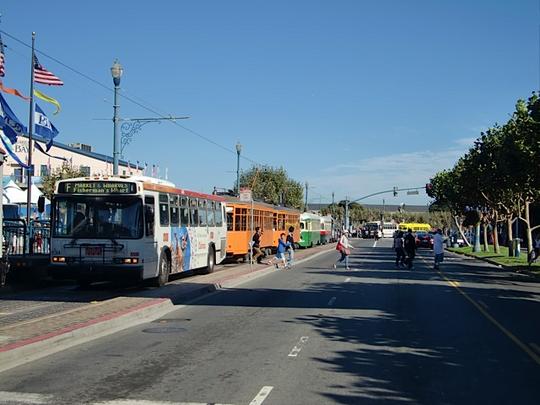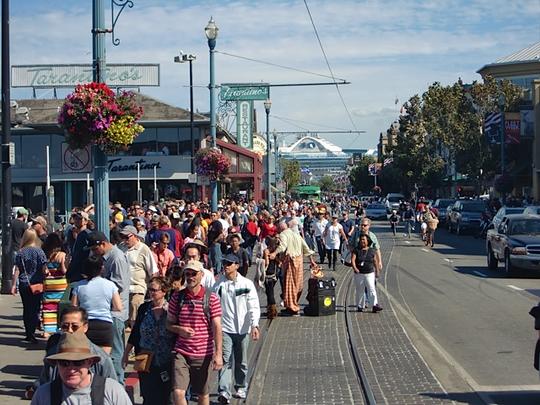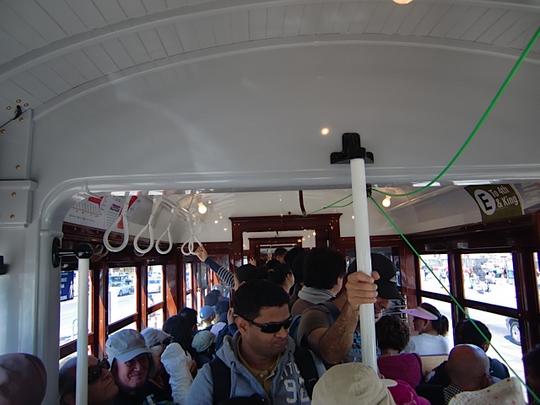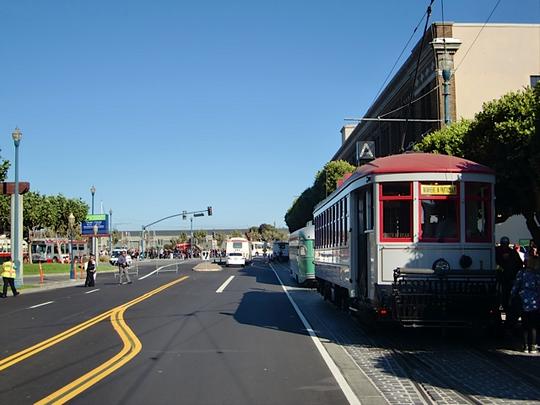
A conga line of buses, Milan trams and PCCs lines up to turn around at Pier 39 while the Wharf portion of the E and F lines was closed for a parade on Sunday — one of the many challenges facing Muni on an extraordinary weekend.
Muni just went through one of its busiest weekends in its hundred-year history, and we at Market Street Railway are helping distill lessons learned, specifically to keep improving the historic streetcar operation.
Muni got good marks in the press for managing an unprecedented confluence of events — Fleet Week, America’s Cup World Series action, an Italian Heritage parade through Fisherman’s Wharf, two Giants playoff games, a 49ers game, the Castro Street Fair, Hardly Strictly Bluegrass, and several other events, along with two huge cruise ships in port.
The Embarcadero was really Ground Zero for the crowds, and as this Chronicle article pointed out, Muni pulled out all the stops it could to cope. (Worth noting here that the Chronicle mis-identified the streetcar carrying fans to AT&T Park as an F-line car when of course it was on the E-Embarcadero.)
This was the second recent demonstration service on the E-line, following an America’s Cup World Series weekend in August. Currently, the E-line can only use double-ended streetcars because the designated southern terminal, at the Caltrain depot, has no place to reverse single-ended streetcars. Muni ran five double-ended PCCs on the E and they were packed all day both Saturday and Sunday.

Pedestrians in the track lane significantly slowed streetcar service over the weekend at the Wharf.
The Wharf end of the operation seemed to pose the most significant challenges. For several hours Sunday, the Italian Heritage parade forced all the streetcars to turn back at Pier 39. At one point, 13 E- and F-line vehicles were queued up waiting to reverse at Pier 39. Even when the streetcars could run all the way to the Jones terminal, though, it was slow going, as pedestrians regularly spilled from the jammed sidewalks onto the track lane.
Market Street Railway and the South Beach-Rincon Hill-Mission Bay neighborhood partnered to turn out numerous docents at key stops along both the E- and F-lines. They provided a lot of helpful information to intending riders, including fares, destinations, how to ride, and so on. This is critical when dealing with large numbers of people who rarely, if ever, ride public transit. Even so, the size of the crowds proved overwhelming at times.

Muni’s flagship, Car 1 (1912) marked its return to regular passenger service with two days of trouble-free operation on the F-line over the busy weekend (even though it carried signs inside suggesting that it was intended for the E-line). It was constantly packed.
The operation of the mixed E- and F-lines provided many valuable lessons. Our docents are sharing their experiences with our board member Bruce Agid, who helped organize our volunteer effort with help from many, including Nick Figone and Paul Lucas. Bruce will be sharing our findings and suggestions with Muni operations, with the goal of avoiding streetcar bunching and slow loading come America’s Cup racing next year.
We’ll share our findings here after we’ve shared and discussed them with Muni officials. Want to emphasize here, though, that given everything else Muni had to deal with all across the city last weekend, our hat’s off to them.

Car No. 1, still signed for the A-Geary (from its ceremonial debut in April) takes its turn in the queue behind Brooklyn PCC No. 1053 boarding riders headed back toward the Ferry Building. Among the recommendations Market Street Railway will pass along to Muni will be ways to speed boarding and operations along the line.
Couldn’t the E-line be supplanted by some LRVs? It would make for a better compromise than a junky bus to those unlucky passengers. (I can see why that might not work so well for F line when running on Market due to trolley wires being just too close together.)
The larger vehicle (especially when doubled up) would also relieve that 13-vehicle queue a bit.
What an exciting weekend! I wish I could have been out there!
I think you mean “augmented” rather than “supplanted.” The short answer is no, at least not north of Mission Street. The overhead on the northern Embarcadero will accommodate pantographs like the LRVs have, but there is not enough electrical capacity to handle more than a couple of them in a mix with vintage streetcars. And they can’t operate on Market Street because, as you mentioned, the pantographs are incompatible with double wire overhead (and the crossings do not have pantograph skids). Technical mumbo-jumbo, but that’s the answer.
Now that some of the Torpedos are back from Brookeville and running, is there any word from Muni on when the E line will start running permanently?